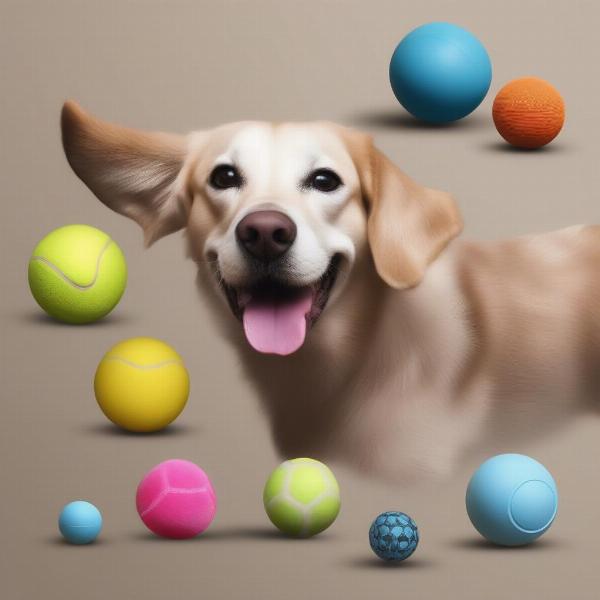Throwing a ball for your dog is a classic pastime enjoyed by both pet and owner. It provides exercise, mental stimulation, and strengthens the bond between you. However, it’s important to choose the right ball and throw it safely to prevent injuries and ensure your dog has a positive experience. This guide will cover everything you need to know about ball throwing for dogs, from choosing the appropriate ball to mastering different throwing techniques.
Choosing the Right Ball
Not all balls are created equal when it comes to canine play. Size, material, and durability are key factors to consider. A ball that’s too small can be a choking hazard, while one that’s too large can be difficult for your dog to pick up and carry. Look for balls specifically designed for dogs, made of durable, non-toxic materials. Avoid tennis balls, as the fuzzy exterior can wear down your dog’s teeth.
Size Matters
The size of the ball should be appropriate for your dog’s breed and size. Small dogs need smaller balls, while larger breeds can handle larger ones. As a general rule, the ball should be large enough that your dog can’t swallow it whole.
Material Matters
Opt for balls made of natural rubber or other durable, non-toxic materials. Avoid balls made of hard plastic, which can chip or break your dog’s teeth.
Durability is Key
Dogs can be rough on their toys, so choose a ball that can withstand a lot of wear and tear. Look for balls made of tough, puncture-resistant materials.
 Choosing the right ball for your dog
Choosing the right ball for your dog
Safe Throwing Techniques
While throwing a ball seems simple, there are techniques you can use to prevent injuries and maximize your dog’s enjoyment. Avoid throwing the ball directly at your dog’s face, as this can cause eye injuries. Instead, aim for open space and encourage your dog to chase and retrieve the ball.
The Overhand Throw
This is the most common throwing technique, but it can put strain on your dog’s joints if done incorrectly. Avoid throwing the ball too high or too far, especially for dogs with joint issues.
The Underhand Throw
This is a gentler throwing technique that’s ideal for shorter distances. It’s less likely to cause strain on your dog’s joints.
The Roller
Rolling the ball along the ground is a great way to encourage your dog to chase and pounce. This is a good option for dogs who are less mobile or have joint problems.
Understanding Your Dog’s Limits
Just like humans, dogs have different levels of fitness and endurance. Pay attention to your dog’s body language and take breaks when needed. Overexertion can lead to injuries, especially in hot weather.
Signs of Overexertion
Panting, excessive drooling, and lagging behind are all signs that your dog needs a break. Provide fresh water and shade, and allow your dog to rest before resuming play.
Conclusion
Throwing a ball for your dog is a fantastic way to bond and provide exercise, but safety and choosing the right ball should always be a priority. By following these guidelines, you can ensure that your dog enjoys countless hours of fun and safe playtime. Remember to choose the right size and material for your dog, use safe throwing techniques, and pay attention to your dog’s limits.
FAQ
- What are the best types of balls for dogs? Look for durable, non-toxic balls made of natural rubber or similar materials. Avoid tennis balls and hard plastic balls.
- How can I prevent my dog from getting injured while playing fetch? Use safe throwing techniques, avoid throwing the ball directly at your dog’s face, and pay attention to your dog’s limits.
- What should I do if my dog swallows a ball? Contact your veterinarian immediately.
- Can I play fetch with my dog every day? Yes, as long as your dog is physically able and enjoys it. Be sure to provide adequate rest and hydration.
- What are some alternatives to ball throwing for exercise? Other options include walks, hikes, swimming, and playing with other dogs.
- How can I teach my dog to fetch? Start with short distances and reward your dog for retrieving the ball. Gradually increase the distance as your dog progresses.
- What if my dog doesn’t like playing fetch? Not all dogs enjoy fetch. Try other games and activities to find something your dog enjoys.
Related Articles on ILM Dog
dogs fetching toy
large balls for dogs
throws for dogs
how to reverse laser pointer syndrome in dogs
About ILM Dog
ILM Dog (ilmdog.com) is your one-stop resource for expert advice on dog care and breeding. We offer practical guidance on a range of topics, including breed selection, health and medical care, training and behavior, nutrition, grooming, exercise, and choosing the right products and accessories for your canine companion. Whether you’re a new dog owner or a seasoned expert, ILM Dog provides valuable insights and tips to help you provide the best possible care for your furry friend. Our expertise extends to helping you find the perfect dog breed for your lifestyle, understanding your dog’s nutritional needs, and addressing behavioral challenges. For all your dog-related questions and concerns, connect with our expert team at [email protected] or call us at +44 20-3965-8624.